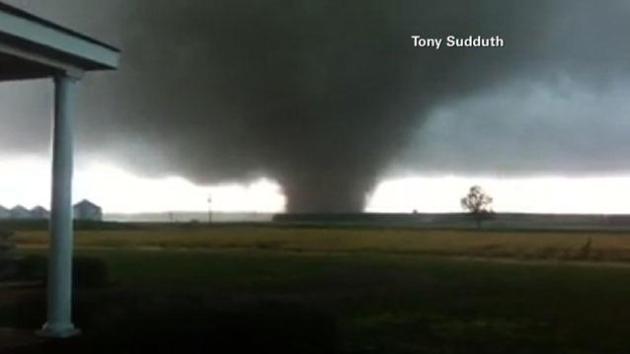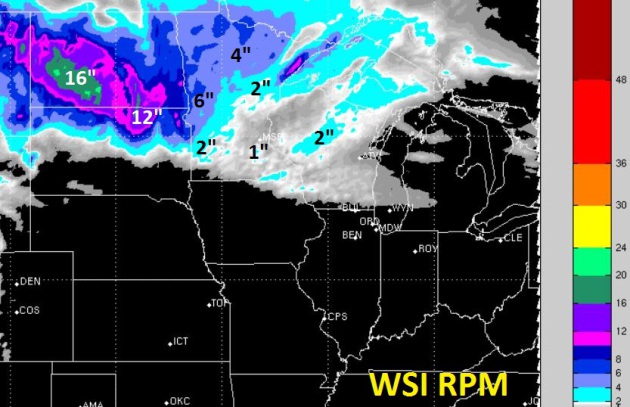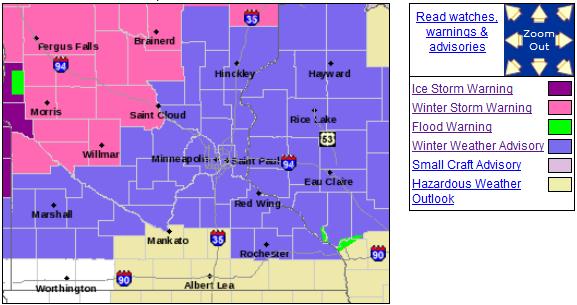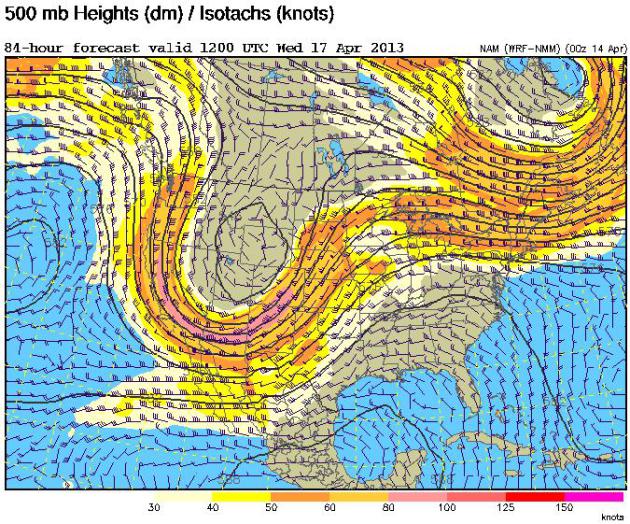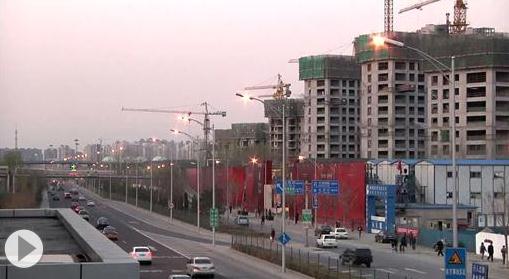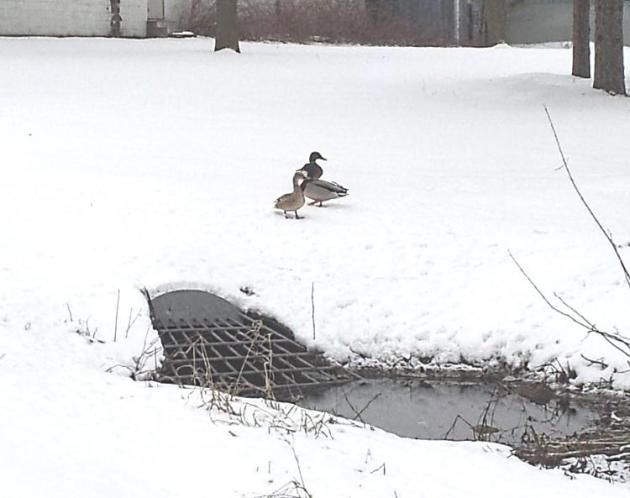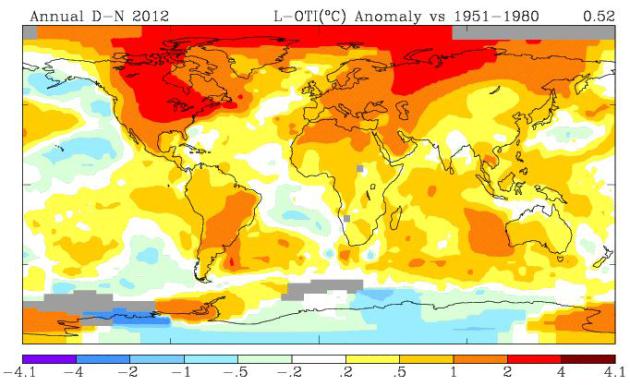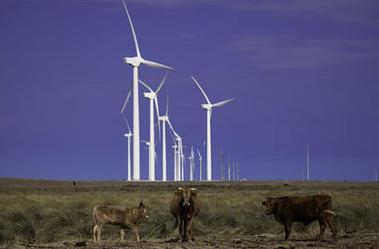Tornado Paranoia
Anyone with a pulse realizes spring is in
trouble. This may be a year where we go from ankle-deep slush to 70s,
virtually overnight. If so - make sure you have fresh batteries in your
NOAA Weather Radio.
I hope I'm wrong on this call - that in a few
months we can look back and laugh. "Yep, one more case of Paul going off
his meds!" But here's the thing: 2013 reminds me of 1965. We suffered
thru a tortured spring in '65: record river flooding; an inch of snow
on April 25 at MSP. Then a light-switch warm-up: 78F on May 6, 1965;
with a swarm of killer EF-4 tornadoes from Lake Minnetonka to Fridley.
Lingering chill over the northern U.S. this year
may spark an even sharper temperature gradient by late spring,
implying stronger jet stream winds and more wind shear, capable of
spinning up extreme tornadoes. Impossible to pin down where, but NOAA
SPC confirms a correlation between cool summers & more twisters.
We'll see, but I just have a feeling.
Ice and slush early gives way to a cold rain
today; another plowable snow up north, delaying & complicating
Minnesota's flood outlook. Next week's big storm will track to our east,
keeping us unnecessarily chilly. 50s may return a week from tomorrow.
No big and beefy warm fronts just yet. Part of
me is relieved, but I want spring as much as the next guy. Just without
the EF-4 tornadoes, please.
7 Tools To Help You Survive Tornado Season. Call me
crazy (heard it before, usually from my wife), but I suspect a much
cooler, wetter, stormier, more severe late spring and summer is shaping
up for Minnesota, with far more tornadoes than 2012. Favorite apps
include RadarScope, My-Cast and WeatherNation, but there are plenty of
good options out there for getting severe weather information. The more
sources, the more "safety nets", the better - the greater the odds
you'll get a potentially life-saving nugget of information when you need
it most. Here's an excerpt from CNN and
NBC Montana: "...
Getting
the latest warnings when tornadoes are headed your way and knowing
what to do before, during and after one hits are all key to staying
safe. A handful of apps can help you stay on top of impending dangerous
weather. Keep in mind that you'll want to save power on your
smartphone in case the electricity goes out, so use it sparingly.
Here are some digital tools to help you through a storm safely.
NOAA Weather Radio
Getting advanced warning of impeding tornadoes is key. If the
electricity goes out and you can't watch weather updates on TV, you can
switch to a battery-powered radio or fire up the NOAA Weather Radio
app ($3.99). This app streams more than 200 NOAA broadcasts and adds in
additional information including radar, push notifications, emergency
warnings for your state and detailed weather reports..."
Not Again. The metro area may pick up a little
slushy snow this morning, mixed with sleet and freezing rain (glaze
ice), before changing to mostly rain by midday and afternoon. Brainerd
may pick up 2-4" of slushy snow, as much as 6" closer to the Dakota
border, with some 12-16" amounts for North Dakota.
Winter Weather Advisory. A mix of wet snow, sleet
and freezing rain will leave roads slushy and slick for a time this
morning over southern Minnesota and western Wisconsin; amounts probably
under 1". Winter Storm Warnings are posted north/west of St. Cloud and
Willmar, for enough snow to plow and shovel. I think spring is going
well...
Another Chilly, Stormy Week. The 84-hour forecast
for 500 mb (18,000 foot) winds shows another deep trough of low
pressure centered over the Rockies, ejecting another storm across the
Plains into the Midwest (the brunt of the moisture probably staying
just east of Minnesota). Unusually warm weather persists over the
southeastern USA much of this week.
Hope (In A Week Or So). ECMWF data shows a cold rain
much of today, drying out Monday and Tuesday; a midweek storm brushing
MSP with more rain, possibly mixed with wet snow (but not as much drama
as last week). Most important: 50s may return a week from today; the
"Euro" hinting at 60F next Monday, April 22. Right.
Hope. Part II. The GFS seems to agree with ECMWF,
which increases our confidence level that it may actually warm up a
little by the end of April. In fact the GFS data shows highs topping 50
from April 22-23 thru the end of the week, even a few 60s after April
26. It's time.
Why Leave Job In Beijing? To Breathe. This is what
happens when the environment takes a back seat to growth and economic
"progress" - the model is simply unsustainable. Here's an excerpt from a
recent story at
The Wall Street Journal: "...
In
January, levels of fine particulate matter measured by the U.S.
Embassy in Beijing reached a level 35 times the World Health
Organization's recommended standard. Off-the-charts pollution has added
to other drawbacks of life in Chinese cities for expatriates: Internet
censorship that slows online speeds and blocks access to sites like Facebook, FB -2.21% Twitter and GoogleGOOG -0.04% Drive; and concerns over food safety and water quality..."
Video clip credit above: "
As China struggles with air
pollution, some believe the air inside is just as bad. Louie Cheng
president of PureLiving China, an indoor environmental consulting firm,
talks about toxic pollutants, your home and what you can do to get
rid of them."
The Wonders Of Our "Spring". Thanks to John Bristow for sending this one in. Yes, the ducks must be irritated too.
From the local National Weather Service. On April 13 in weather history:
1983: "Surprise" snowstorm covers
east central Minnesota. The Twin Cities measured 13.6 inches. Brilliant
blue skies and bright sun the morning after.
1886: St. Cloud-Sauk Rapids
tornado. It left 72 people dead. 80 percent of all buildings in Sauk
Rapids were leveled as the tornado expanded to 800 yards across. When it
crossed the Mississippi it knocked down two iron spans of a wagon
bridge and local witnesses said the river was "swept dry" during the
tornado crossing. There was 300,000 dollars damage in Sauk Rapids and
only 4,000 dollars worth was insured. The forecast for that day was for
local rains and slightly warmer with highs in the 50's.
Bark Three Times. That's my dog, Leo, staring out
the window, searching for signs of spring. I'll let you know when he
spots a legitimate warm front.
Climate Stories...
Global Warming Over Land Is Real; CU-Boulder, NOAA Study. Although
most of the warming is going into the world's oceans, atmospheric
warming over land areas is real, and quantifiable. Here's an excerpt
from
Huffington Post: "
The
thermometers got it right. The Earth is warming, another study is
reporting. Climate scientists recognize that changes in weather
observation stations' immediate surroundings -- such as neighboring
trees being replaced by heat-absorbing concrete -- can eventually throw
data from such stations into question. But now, a new study directed
by a researcher at the National Oceanic and Atmospheric Administration
that recreates climate history without the use of land-based
observation systems shows the same thing that thermometers have been
reporting. "This shows that global warming over land is real," said
Gilbert Compo, a scientist at NOAA's Cooperative Institute for Research
in Environmental Sciences at the University of Colorado. "It is not
an artifact of the observing system," said Compo, lead author of the
study, which he presented to the European Geophysical Union on Tuesday
in Vienna. "It is happening..." (image: NASA)
It's Official: EPA Delays Climate Rule For New Power Plants.
The Washington Post has the latest; here's an excerpt: "
You might have been wondering whether the Obama administration was going to impose the first-ever greenhouse gas limits on new power plants, since the deadline is April 13. We reported nearly a month ago that the Environmental Protection Agency was
likely to delay the rule to bolster their legal case for imposing the
new carbon restrictions. On Friday, EPA spokeswoman Alisha
Johnson confirmed that the agency would not finalize the controversial
proposal on time. Johnson said in an e-mail that the agency was still
reviewing more than 2 million comments on its proposal..."
California Sets Wind Power Records During High-Wind Event. KCET has the details: "
More
wind power than ever has powered the state in the last few days,
according to the California Independent System Operator (CaISO), which
runs the electrical power grid covering most of the state. On Sunday,
wind power production reached an all-time peak of 4,196 megawatts --
nearly twice the output of the shuttered San Onofre nuclear power
plant. All told Sunday, wind turbines generated 70,560 megawatt-hours
of electrical power throughout the day, 13 percent of the state's total
electrical power consumption..." (file photo: Business Wire).
How The Economist Got It Wrong. No warming since
1998 - nothing to worry about? It would be nice if it were true. Here's
another perspective on a recent Economist article that has been getting
a lot of play in climate-denier circles, published at
Australia's ABC Network: "...
While
we are pleased that The Economist brought attention to this important
topic, we were disappointed by the shortcomings and inaccuracies in
the piece with regard to the current state of scientific
understanding. The article focused heavily on claims that the slowed
warming of Earth's surface in recent years implies a dramatically
lowered estimate of climate sensitivity. The claim was primarily
supported by a single as-yet unpublished article by
a group in Norway, which attempts to use instrumental temperature
evidence available back through the late 19th century to estimate the
climate sensitivity. The authors of that article conclude that use of
data to the year 2000 yields a climate sensitivity of 3.9°C, which is at
the high end of the generally accepted 2 to 4.5°C range. Yet they
find that by including just an additional decade of data (i.e. using
observations available through 2010), the estimate falls by nearly
half, to 1.9°C. It should be a red flag that an estimate of climate
sensitivity would change by a factor of two based only on the addition
of a decade of data. In reality, the climate sensitivity now is not
half what it was a decade ago. So where did the Norwegian study go
wrong?..."
Climate Skepticism Comes In Many Shades of Gray. Here's an excerpt of a great post from
Bart Verheggen explaining why some people have so much difficulty accepting the science: "
It has long puzzled me why so many people don’t accept the science. There
is a tremendous difference in opinion about climate change amongst
the lay public as compared to in the scientific community. I’m hardly alone in pondering the question of why (see e.g. this insightful post).
It’s clearly an important issue if we are to increase the public’s
understanding of climate change. Of course it is only to be expected
that some people are skeptical: Naturally there is a spectrum of
opinions. But that does not explain why that spectrum is so dramatically
different between different groups of people (the lay public and the
professional scientists in this case). To name a few plausible
reasons:
- Ideology
can be a strong driver of how people view the science:
Mitigation of climate change is seen as threatening by many
libertarians, because they associate mitigation with government
intervention, which they oppose.
- Psychology
can also be very powerful: To some it feels good to be the
underdog and get celebrated by anonymous fans on the internet and
phoned up routinely by newspapers, TV and other media (that counts
for the ‘spokespeople’ only)..."
Climate Change: How A Warming World Is A Threat To Our Food Supplies. Here's a snippet of a story at
The Guardian: "...
Drought, rocketing bread prices, food and water shortages have all blighted parts of the Middle East. Analysts at the Centre for American Progress
in Washington say a combination of food shortages and other
environmental factors exacerbated the already tense politics of the
region. As the Observer reports today, an as-yet unpublished US
government study indicates that the world needs to prepare for much
more of the same, as food prices spiral and longstanding agricultural
practices are disrupted by climate change...."
Photo credit above: "
Souaibou Toure, head of a cereal cooperative in Mali." Photograph: Tadej Znidarcic.

